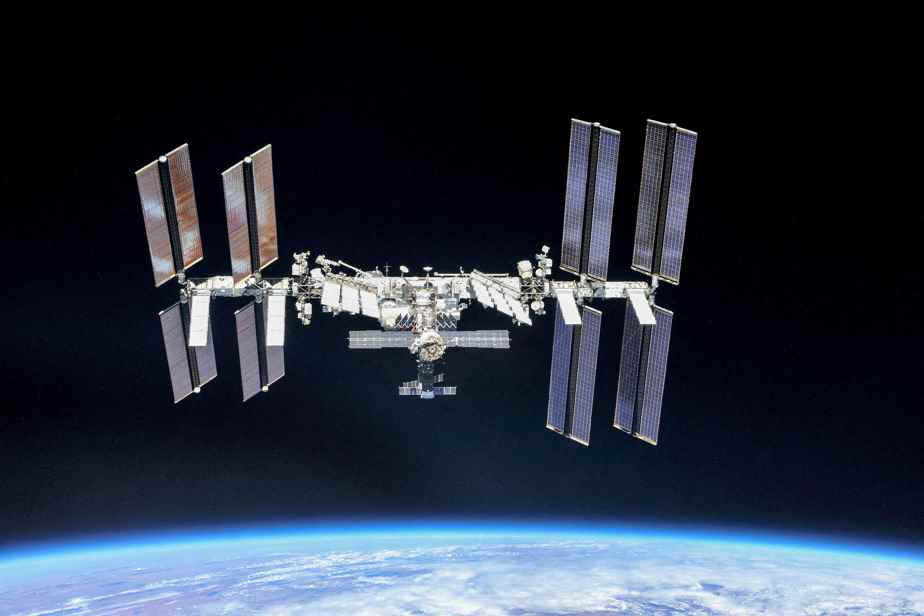Russia is blowing hot and cold in space. Last Tuesday, the new big boss of Roscosmos announced during a television interview with Vladimir Putin the end of his collaboration with the International Space Station (ISS) “after 2024”. But another senior official indicated the same day, in a Russian magazine, that the country would remain a partner of the ISS until the start of the construction of the future Russian orbital station, scheduled for 2028. Can the West operate alone? the ISS?
Posted at 7:00 a.m.
key module

PHOTO FROM NASA WEBSITE
The Russian module Zvezda (to the left)
Russia’s main contribution to the International Space Station is the module’s propulsion Zvezda, one of the seven Russian modules. “It is absolutely necessary that Zvezda works so that the ISS can continue to be in service,” says Kuan-Wei Chen, a specialist in space law from McGill University. “Normally, you have to give a year’s notice to withdraw from the ISS, and NASA said this week that it had heard nothing. This is not the first time that Russia has made this kind of threat. Should the other partners of the ISS buy the Russian modules? “Probably,” said Mr. Chen. We could not replace Zvezda by another propulsion module because all the modules are interconnected. I know we started to think about how to operate Zvezda with western technology. The Canadian Space Agency said it had no new information about Russian intentions.
The Russian station

PHOTO FROM ROSCOSMOS WEBSITE
Illustration of the Russian Orbital Service Station
The module Zvezda as well as the first Russian module, Zarya, are increasingly difficult to repair because they have exceeded their useful life of 15 years by 10 years, indicated in an internal magazine of Roscosmos, the Russian space agency, the head of the Russian segment of the ISS Vladimir Solovyov. Building a Russian Orbital Service Station (ROSS) would therefore reduce operating costs, he said. If ROSS funding is approved this year, a first habitable module will be put into orbit in 2028, then two laboratories and a satellite repair and refueling platform in 2030. A new capsule to transport cosmonauts and equipment, Oriol (eagle), is also provided.
Solovyov said it was absolutely necessary for Russia to participate in the ISS until the ROSS was habitable to avoid “losing expertise”, referring to the abandonment of the space shuttle buran in the late 1980s. Russia probably spends several hundred million dollars a year on its ISS modules, according to John Logsdon, a space political scientist at Georgetown University in Washington. “We don’t know the Russian budget for the ISS, but for the other partners, it’s around 1.5 billion US per year. »
Sino-Russian projects

PHOTO FROM ROSCOSMOS WEBSITE
Artist’s impression of the Sino-Russian moon base
Last year, China and Russia announced a joint lunar base project for the 2030s. And Russia said it could send cosmonauts aboard the Chinese space station. Tiangong (heavenly palace), under construction and inhabited since last year. “For China, the half-century of Russian experience is invaluable,” Chen said. After all, the Russians were the first to inhabit space stations, as early as the 1970s with the program Salyut. After 30 years of global collaboration in space, we are returning to a bipolar world, like during the Cold War. Russia and China also want to collaborate on the design of a satellite geolocation system like GPS. » Could we see a Russian module on Tiangong ? “I think there would be a compatibility issue,” says Logsdon.
Lessons from the ISS
China’s space station has benefited greatly from the ISS experience, Logsdon thinks. “It is much smaller, so less expensive to build and maintain. We realized that it is useless to have three laboratories like in the ISS, because the astronauts do not have enough time to use them full time. There is also a limit to the demand from the scientific community, which cannot devote its entire budget to experiments on board the ISS. »
ISS modules
- Bigelow : American experimental inflatable module launched in 2016
- Canada arm (unpressurized): Launched in 2001
- columbus : European laboratory launched in 2008
- Cupola : Euro-American Observatory launched in 2010
- destiny : American laboratory launched in 2001
- harmony : US service module launched in 2007
- Kibo : Japanese laboratory launched in 2008
- Leonardo : Italian-American storage launched in 2011
- Nauka : Russian laboratory launched in 2021
- pirs : Russian airlock launched in 2001 and replaced in 2021 by Nauka
- Poisk : Russian airlock launched in 2009
- Prichal : Russian airlock launched in 2021
- Quest : American airlock launched in 2001
- Rassvet : Russian airlock launched in 2010
- Tranquility : Euro-American wastewater treatment plant launched in 2010
- Unity : Connection between Russian and Western sections, launched in 1998
- Zarya : Russian service module launched in 1998
- Zvezda : Russian accommodation and propulsion module launched in 2000
Learn more
-
- 108 meters
- Diameter of the International Space Station
Source: NASA
- 20 meters
- Chinese station diameter Tiangong
Source: NASA
-
- 31 meters
- Diameter of the Russian station Mir (1986-2001)
Source: NASA
- 25 meters
- American station diameter skylab (1973-1974)
Source: NASA

